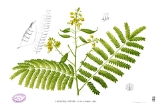
Sappanwood
Encyclopedia
Caesalpinia sappan is a species of flowering
tree
in the legume family, Fabaceae
, that is native to Southeast Asia
and the Malay archipelago
. Common names include Sappanwood, Sapanwood, and Suou (Japanese
). Sappanwood belongs to the same genus as Brazilwood
(C. echinata), and was originally called "brezel wood" in Europe.
This plant has many uses. It possesses medicinal abilities as an anti-bacterial and for its anti-coagulant properties. It also produces a valued type of reddish dye
called brazilin
, used for dyeing fabric as well as making red paints and inks. The wood
is somewhat lighter in color than Brazilwood and its other allies, but the same tinctorial principle appears to be common to all.
Sappanwood was a major trade good during the 17th century, when it was exported from Southeast Asian nations (especially Siam) aboard red seal ships
to Japan
.
Flowering plant
The flowering plants , also known as Angiospermae or Magnoliophyta, are the most diverse group of land plants. Angiosperms are seed-producing plants like the gymnosperms and can be distinguished from the gymnosperms by a series of synapomorphies...
tree
Tree
A tree is a perennial woody plant. It is most often defined as a woody plant that has many secondary branches supported clear of the ground on a single main stem or trunk with clear apical dominance. A minimum height specification at maturity is cited by some authors, varying from 3 m to...
in the legume family, Fabaceae
Fabaceae
The Fabaceae or Leguminosae, commonly known as the legume, pea, or bean family, is a large and economically important family of flowering plants. The group is the third largest land plant family, behind only the Orchidaceae and Asteraceae, with 730 genera and over 19,400 species...
, that is native to Southeast Asia
Southeast Asia
Southeast Asia, South-East Asia, South East Asia or Southeastern Asia is a subregion of Asia, consisting of the countries that are geographically south of China, east of India, west of New Guinea and north of Australia. The region lies on the intersection of geological plates, with heavy seismic...
and the Malay archipelago
Malay Archipelago
The Malay Archipelago refers to the archipelago between mainland Southeastern Asia and Australia. The name was derived from the anachronistic concept of a Malay race....
. Common names include Sappanwood, Sapanwood, and Suou (Japanese
Japanese language
is a language spoken by over 130 million people in Japan and in Japanese emigrant communities. It is a member of the Japonic language family, which has a number of proposed relationships with other languages, none of which has gained wide acceptance among historical linguists .Japanese is an...
). Sappanwood belongs to the same genus as Brazilwood
Brazilwood
Caesalpinia echinata is a species of Brazilian timber tree in the pea family, Fabaceae. Common names include Brazilwood, Pau-Brasil, Pau de Pernambuco and Ibirapitanga . This plant has a dense, orange-red heartwood that takes a high shine, and it is the premier wood used for making bows for...
(C. echinata), and was originally called "brezel wood" in Europe.
This plant has many uses. It possesses medicinal abilities as an anti-bacterial and for its anti-coagulant properties. It also produces a valued type of reddish dye
Dye
A dye is a colored substance that has an affinity to the substrate to which it is being applied. The dye is generally applied in an aqueous solution, and requires a mordant to improve the fastness of the dye on the fiber....
called brazilin
Brazilin
Brazilin is a red pigment obtained from the wood of the brazilwood family , and is also known as Natural Red 24. Brazilin has been used since at least the Middle Ages to dye fabric, and has been used to make paints and inks as well...
, used for dyeing fabric as well as making red paints and inks. The wood
Wood
Wood is a hard, fibrous tissue found in many trees. It has been used for hundreds of thousands of years for both fuel and as a construction material. It is an organic material, a natural composite of cellulose fibers embedded in a matrix of lignin which resists compression...
is somewhat lighter in color than Brazilwood and its other allies, but the same tinctorial principle appears to be common to all.
Sappanwood was a major trade good during the 17th century, when it was exported from Southeast Asian nations (especially Siam) aboard red seal ships
Red seal ships
were Japanese armed merchant sailing ships bound for Southeast Asian ports with a red-sealed patent issued by the early Tokugawa shogunate in the first half of the 17th century...
to Japan
Japan
Japan is an island nation in East Asia. Located in the Pacific Ocean, it lies to the east of the Sea of Japan, China, North Korea, South Korea and Russia, stretching from the Sea of Okhotsk in the north to the East China Sea and Taiwan in the south...
.

